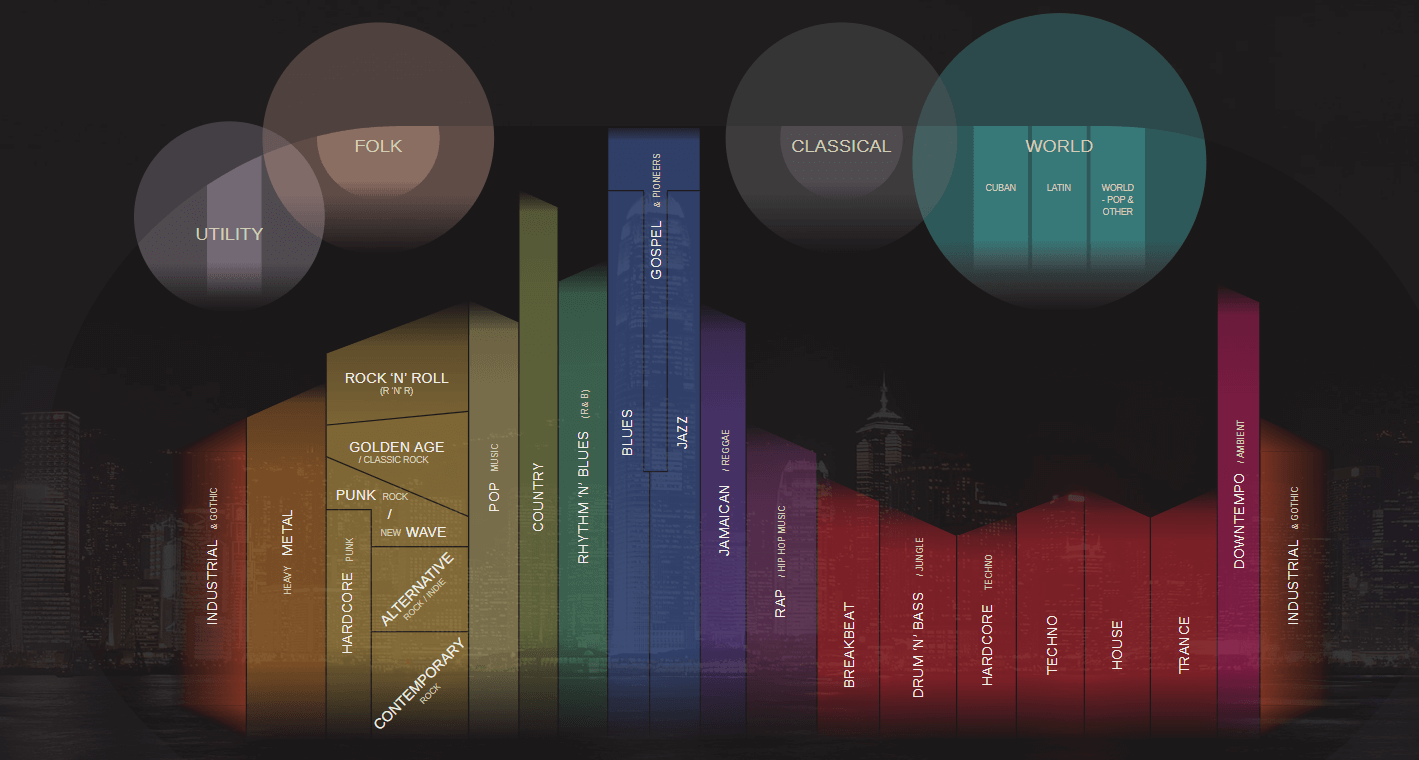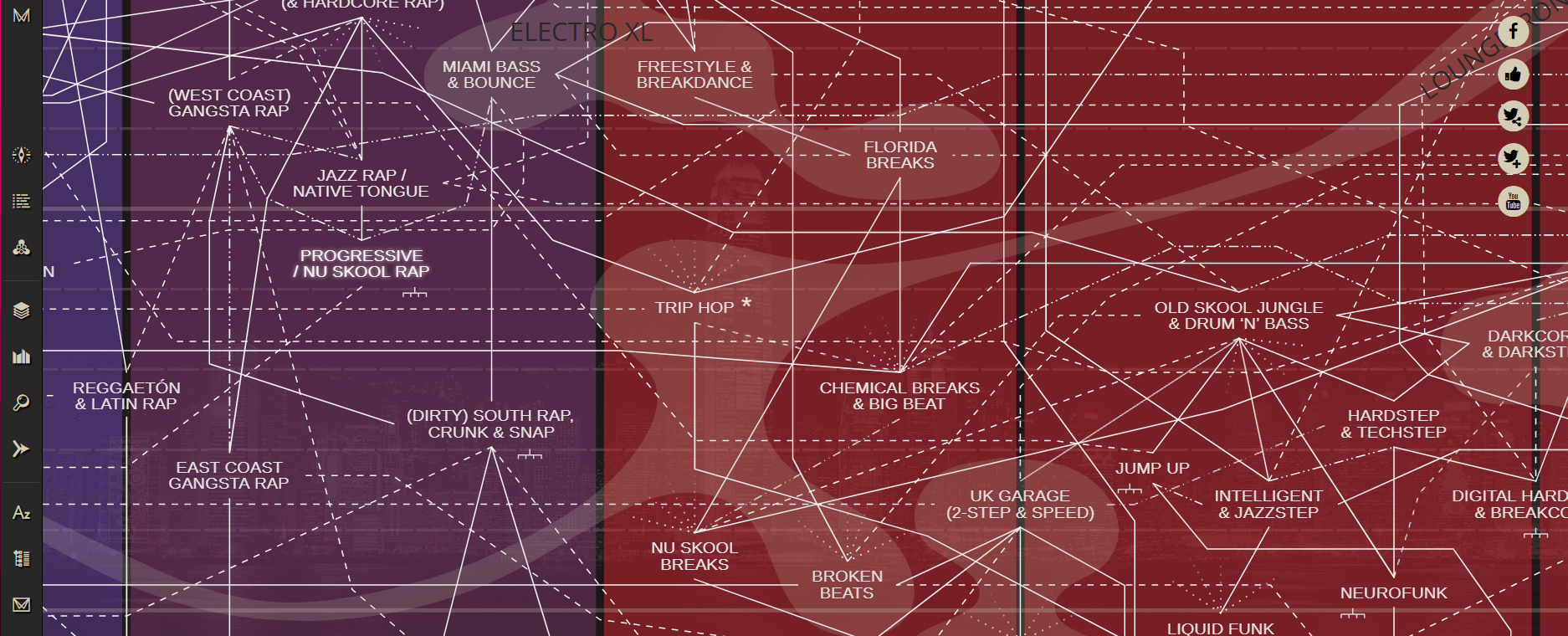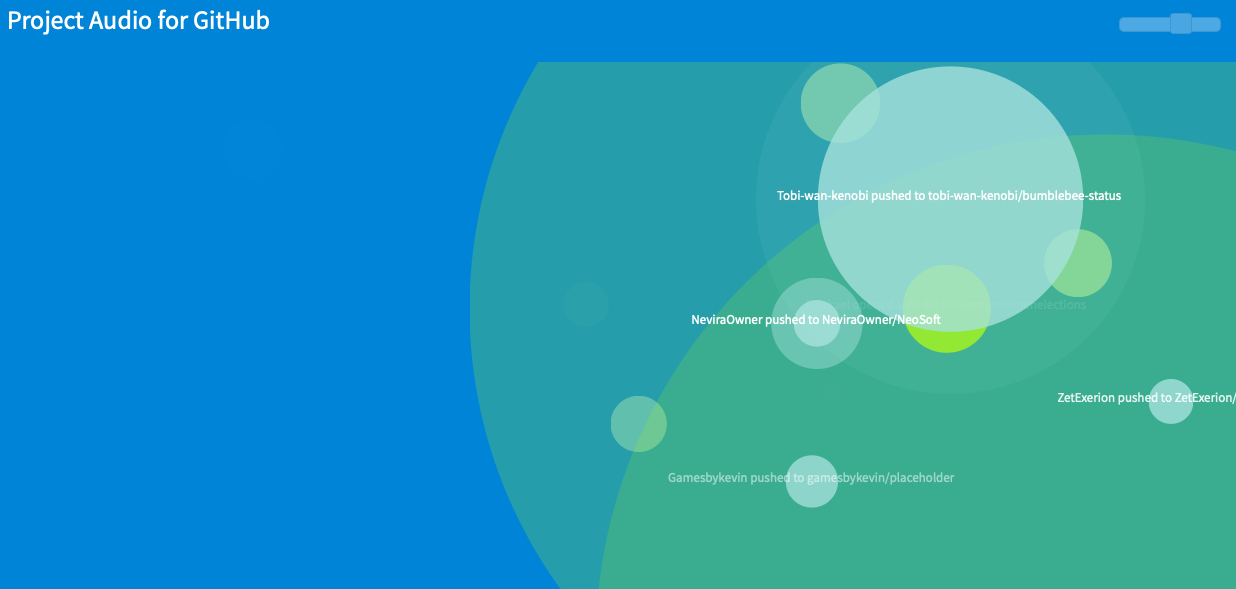Last time we
talked about cards that have all kinds of audio information. We continue the theme of musical finds and talk about services in which you can "stick".
 Photo Cristofer Jeschke / Unsplash
Photo Cristofer Jeschke / Unsplash
This is a service with interactive infographics, which is a family tree of musical genres: from 1880 to the present.
It was
launched by Belgian architect Kwinten Crauwels along with his brother-programmer. The idea of the project was born at a time when the brothers could not find a resource dedicated to the review of all musical genres. Therefore, they decided to do it themselves.
As Quinten
said at the TED conference in 2017, it took more than eight years to launch the service. During this time, the authors studied 230 musical directions and established connections between them.
 Screenshot: musicmap.info / Service home screen with main music genres
Screenshot: musicmap.info / Service home screen with main music genresThe service map is a multi-colored bar chart. Each color corresponds to one of the primary genres, for example, jazz (blue), rock (yellow) and dance music (red). Each color is divided into super genres - hardcore, alternative, punk and others.
If you enlarge the image, the picture will change. Many subgenres connected by lines appear in the columns. They indicate the connection of musical directions with each other. Solid - close connection, dotted - lesser degree of influence.
 Screenshot: musicmap.info / Some subgenres from the rap, breakbeat and drum and bass categories
Screenshot: musicmap.info / Some subgenres from the rap, breakbeat and drum and bass categoriesIf you click on the name of any musical direction, a panel with its brief history will open. Also at the bottom there will be a playlist with cult compositions of this subgenre on YouTube.
Among them you can find quite interesting examples, for example, the work of the Scottish drum and base band
Konflict - “
Messiah ” (neurofunk), the track of the Irish rock band My Bloody Valentine - “
When You Sleep ” (dream pop) and the composition of a jazz musician
Arilda Andersen - "
Anima " (Norwegian jazz).
In general, finding the genre you are interested in is quite simple - there is a search on the site (in the left panel). Below it you will find a list of references used by the authors during the research.
Many satellites involved in various space experiments revolve in Earth’s orbit. Everyone can monitor their broadcast. To do this, you can use a special web receiver to listen to the air - WebSDR.
This is a service that combines many software-defined radio systems (
SDRs ) connected to the Internet. Its author
was an engineer from the
observatory in Dwingelo (Netherlands), where a 25-meter radio telescope was installed. It is part of the
Earth – Moon – Earth communications complex, which uses the Earth’s natural satellite as a reflector to transmit signals to different points on the planet. The Dutch engineer created a special server software so that ham radio enthusiasts from around the world can listen to the radio telescope. Later, some users expressed a desire to set up their own WebSDR server. Today, on the project website, you can connect to 162 software-defined radio systems.
The list
contains SDR , which is supported by engineers from the city of Farnham (UK). She receives telemetry from high-altitude balloons and the International Space Station. Another example is the
server of the Gunhilli satellite earth station , through which you can listen to the broadcast of the Qatari satellite Es'hail 2, launched aboard the SpaceX Falcon 9 rocket last year.
 Screenshot: websdr.org / KiwiSDR - Web Receiver in Chongqing, China
Screenshot: websdr.org / KiwiSDR - Web Receiver in Chongqing, ChinaBy the way, if you have your own transceiver station, you can also open access to it for the general public. To do this, you will need server software that you can ask the creator of WebSDR directly - just write him
an email .
This project is a kind of musical instrument on which developers from around the world “play”. The app plays sounds every time someone performs a push, merge or notes issue on GitHub.
All actions are also reflected on the site page in the form of circles of a certain color. If you click on the appropriate circle, you will be taken to the repository of the developer who performed this or that action.
 Screenshot: github.audio
Screenshot: github.audioThe meditative melody that comes out is like playing a xylophone. The volume can be adjusted using the slider in the upper right corner of the screen (the service does not work in Safari on the iPhone).
The author of the project was Sudhanshu Mishra, who introduced it in 2016. The project is completely open, the code can be found
in the github-audio repository . By the way, the name of the application caused some confusion in the IT community. Some Hacker News residents
first thought that the developers of GitHub decided to introduce a new version control service for musicians.
Note that github-audio has an analogue -
bitlisten . Only he generates a melody based on transactions conducted in the Bitcoin blockchain.
Additional reading - in our "World of Hi-Fi": Listening to informational noise: music and videos that no one should have found
Listening to informational noise: music and videos that no one should have found “Everything you read will be used against you”: how rap music got into the courtroom
“Everything you read will be used against you”: how rap music got into the courtroom Like the crack of a fire, the creaking of doors and ordinary noise become music
Like the crack of a fire, the creaking of doors and ordinary noise become music “They are watching us”: what can happen in an inconspicuous minivan right under your window
“They are watching us”: what can happen in an inconspicuous minivan right under your window “Finds of an audio man”: sound cards as a way to plunge into the atmosphere of an unfamiliar city
“Finds of an audio man”: sound cards as a way to plunge into the atmosphere of an unfamiliar city How to visualize sound on the web: a selection of subject materials with theory and practice
How to visualize sound on the web: a selection of subject materials with theory and practice What is musical programming: who does it and why
What is musical programming: who does it and why